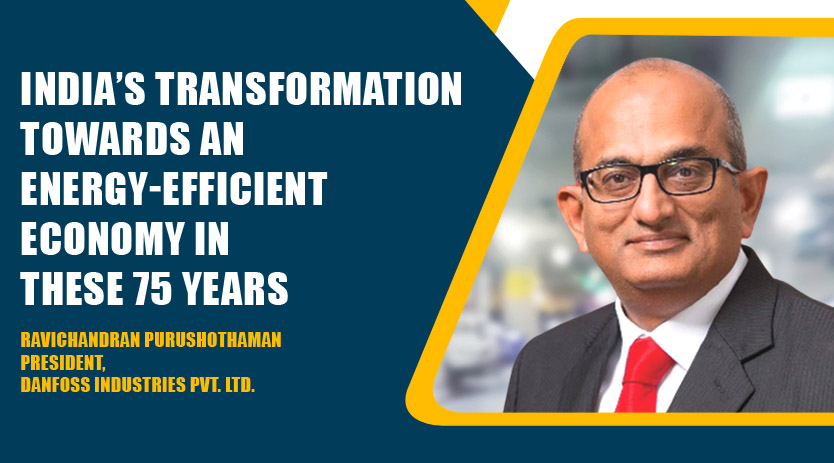The government’s emphasis on green energy has opened the floodgates for tremendous opportunities in the field of energy conservation.
As India stands at the precipice of rapid growth this Independence Day, all eyes are set on its green restart strategies to spearhead this growth and the move towards sustainability. India’s announcement that it aims to reach carbon neutrality by 2070 and meet 50 per cent of its energy requirements from renewable energy sources by 2030 – is a critical moment in the global fight against climate change. Moreover, it is pioneering a new economic development model that could slowly decouple growth and energy requirements by adopting less carbon intensive approaches and, in turn, provide an inspiring blueprint for other developing economies.
Renewable electricity is growing fast in India, with new capacity additions doubling by 2026. To achieve a 33-35 per cent reduction in emissions intensity by 2030, India has reduced emissions intensity by 21 percent as a proportion of its GDP[1]. The country is also one of the world’s largest producers of modern bio-energy. Moreover, the share of solar and wind in India’s energy mix have grown phenomenally. Thus, the scale of transformation in these 75 years has been impeccable.
Danfoss’ contribution to India’s journey toward an energy-efficient economy
Danfoss commenced manufacturing in India in 1998 and has been steadily increasing manufacturing capabilities and localisation footprint in India over the years. Currently, Danfoss has manufacturing capabilities in Chennai, Pune, and Baroda. Danfoss’ Chennai campus is India’s first LEED platinum-rated manufacturing facility. It has several green milestones to its credit, like; a 1.25 MW Solar Power plant and a 275 KW capacity Energy Storage System (ESS), which is India’s first privately held battery-based ESS. Most campus energy requirements are met through renewables – solar and wind- and with the ESS (Energy Storage System), Diesel Gensets are a thing of the past here.In line with the government’s “Make in India”initiative, Danfoss kick-started its version of the same with a new manufacturing campus at Oragadam, Chennai. Danfoss has a three step approach: to make in India for the Indian Market, make in India for the rest of the world, and manufacture components in India for application in global innovations.
Danfoss’ efforts to further the country’s goals for a greener and carbon-free India through industry academia collaborations entered into an MoU with the Indian Institute of Science, Bangalore, to promote the research and training of Low GWP and natural refrigerant. This helps to provide energy-efficient infrastructure to most airports in India. Setting up district cooling projects like GIFT City in Gujarat has helped the management consume 65-80 percent of energy compared to conventional air-conditioning. Also developed is the Turbocor Processor, which was ideated and innovated in India and is now being exported to the rest of the world, including the export hub: China. Danfoss has historically looked favourably upon the Indian market for its potential for tremendous growth. It intends to provide smart technologies that are sustainable and feasible as mandated for smart cities in India.
Government policies that promote green energy
The emphasis laid by the government on green energy has opened the floodgates for tremendous opportunities in the field of energy conservation. For example, standards and Labelling by the Bureau of Energy Efficiency (BEE), Energy Conservation Building Codes (ECBC) by the Ministry of Power, and the Promotion of Electric vehicle: – National Electric Mobility Mission Plan (NEMMP), among others, all contribute to achieving energy efficiency goals.
The Union budget has proposed to allocate an additional fund of ₹10 billion to Solar Energy Corporation of India (SECI) and ₹15 billion to the Indian Renewable Energy Development Agency (IREDA) to augment the overall growth of the renewable sector. The finance minister has also declared the launch of the National Hydrogen Mission to produce green hydrogen using renewable power sources. The efforts by the government to install solar rooftops on public buildings, introduce massive solar plant schemes, and offer incentives to households for solar panel installation are also critical steps for promoting renewable adoption.
India’s green finance landscape
It has three notable characteristics; First, green capital costs are higher because of its unconventional nature, the risks involved, and the lack of a clear regulatory framework. Second, there is a lack of verifiable green financial products in the market. Last, there is a predominance of projects for renewable energy capacity addition, with little to no allocations for energy efficiency. Finally, difficult sectors like infrastructure, industry, resource efficiency, and transport have little to no projects.
Disclosures by companies on the environmental impact of their actions are imperative to promote investor confidence. Setting up disclosure standards in these reports could help eliminate the information asymmetry for investors and lower the cost of foreign capital. Setting up special funds to cover the risks involved and mandating green lending norms by the central bank could be the other way to improve such investments’ viability. Thus, mobilising funds for green purposes necessitates a mix of policy support, regulations, and risk mitigation instruments. Its success will depend on how much we can strategically use public funds and policies to fill the viability gap and scale up investments.
Despite several efforts by the government and industry players, India faces several pressing nearterm challenges. The sharp rise in commodity prices has made energy less economical, while tight markets are increasing energy security risks for the world’s third largest energy importer. In addition, continued dependence on traditional fuels for cooking causes needless harm to people’s health. The most crucial factor, however, is the general lack of understanding and acceptance of renewable energy transformation across industries despite its role in increasing the productivity of companies, improving customer experience, and exploring newer business models. Support from the international community is imperative to shift India’s development onto a low-carbon path. Also, access to low-cost, long-term capital is key to achieving net zero.
Achieving net zero is not just about lowering greenhouse gas emissions. India’s energy transition needs to benefit its citizens, and well-designed policies can restrict the potential trade-offs between affordability, security, and sustainability. A shift to green energy is a huge economic opportunity. India is precisely well placed to become a global leader in renewable batteries and green hydrogen. As a large developing economy with over 1.3 billion people, India’s energy ambitions are not just transformational for India but the entire planet.
India announced new climate targets at COP26 under its ‘Panchamrit strategy’. It has taken a bold leap toward cementing its commitment to energy efficiency and letting the world know its future approach to fighting climate change. The fivefold strategy to fight climate change, termed Panchamrit, was announced by Indian Prime Minister Narendra Modi at the COP26 meeting in Glasgow. The strategy includes a target year for reaching carbon neutrality by 2070. Danfoss is committed to sustainably transforming these goals into reality and Engineer Tomorrow’s India. It is proud to have been a trusted partner in transforming India’s dream of increased adoption of energy efficiency and renewables into an achievable vision. With the perfect marriage of scale and skill, this partnership will soon accelerate the shift to cleaner, more efficient technologies.
Cookie Consent
We use cookies to personalize your experience. By continuing to visit this website you agree to our Terms & Conditions, Privacy Policy and Cookie Policy.













